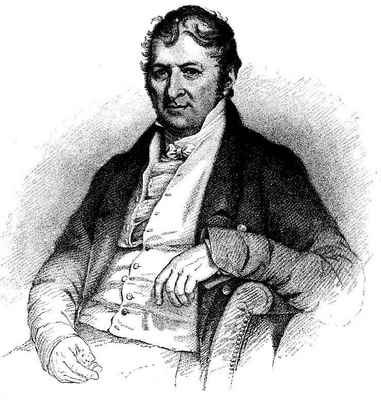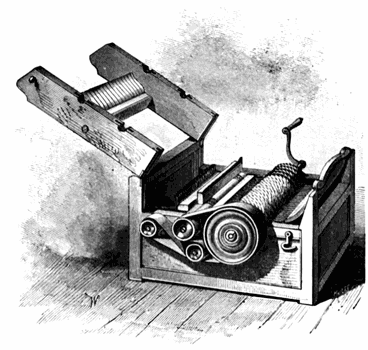Eli Whitney

Eli Whitney was the inventor of the cotton gin and a pioneer in the mass production of cotton. Whitney was born in Westboro, Massachusetts on December 8, 1765 and died on January 8, 1825. He graduated from Yale College in 1792. By April 1793, Whitney had designed and constructed the cotton gin, a machine that automated the separation of cottonseed from the short-staple cotton fiber.
Advantages of Eli Whitney's Cotton Gin
Eli Whitney's invention of the cotton gin revolutionized the cotton industry in the United States. Prior to his invention, farming cotton required hundreds of man-hours to separate the cottonseed from the raw cotton fibers. Simple seed-removing devices have been around for centuries, however, Eli Whitney's invention automated the seed separation process. His machine could generate up to fifty pounds of cleaned cotton daily, making cotton production profitable for the southern states.
Eli Whitney Business Woes
Eli Whitney failed to profit from his invention because imitations of his machine appeared and his 1794 patent for the cotton gin could not be upheld in court until 1807. Whitney could not stop others from copying and selling his cotton gin design.
Eli Whitney and his business partner Phineas Miller had decided to get into the ginning business themselves. They manufactured as many cotton gins as possible and installed them throughout Georgia and the southern states. They charged farmers an unusual fee for doing the ginning for them, two-fifths of the profits paid in cotton itself.
Copies of the Cotton Gin
And here, all their troubles began. Farmers throughout Georgia resented having to go to Eli Whitney's cotton gins where they had to pay what they regarded as an exorbitant tax. Instead planters began making their own versions of Eli Whitney's gin and claiming they were "new" inventions. Phineas Miller brought costly suits against the owners of these pirated versions but because of a loophole in the wording of the 1793 patent act, they were unable to win any suits until 1800, when the law was changed.
Struggling to make a profit and mired in legal battles, the partners finally agreed to license gins at a reasonable price. In 1802, South Carolina agreed to purchase Eli Whitney's patent right for $50,000 but delayed in paying it. The partners also arranged to sell the patent rights to North Carolina and Tennessee. By the time even the Georgia courts recognized the wrongs done to Eli Whitney, only one year of his patent remained. In 1808 and again in 1812 he humbly petitioned Congress for a renewal of his patent.
Eli Whitney - Other inventions
In 1798, Eli Whitney invented a way to manufacture muskets by machine so that the parts were interchangeable. Ironically, it was as a manufacturer of muskets that Whitney finally became rich.
The cotton gin is a device for removing the seeds from cotton fiber. Simple devices for that purpose have been around for centuries, an East Indian machine called a charka was used to separate the seeds from the lint when the fiber was pulled through a set of rollers. The charka was designed to work with long-staple cotton, but American cotton is a short-staple cotton. The cottonseed in Colonial America was removed by hand, usually the work of slaves.
Eli Whitney's Cotton Gin

Eli Whitney's machine was the first to clean short-staple cotton. His cotton engine consisted of spiked teeth mounted on a boxed revolving cylinder which, when turned by a crank, pulled the cotton fiber through small slotted openings so as to separate the seeds from the lint -- a rotating brush, operated via a belt and pulleys, removed the fibrous lint from the projecting spikes.
The gins later became horse-drawn and water-powered gins and cotton production increased, along with lowered costs. Cotton soon became the number one selling textile.
Demand For Cotton Grows
After the invention of the cotton gin, the yield of raw cotton doubled each decade after 1800. Demand was fueled by other inventions of the Industrial Revolution, such as the machines to spin and weave it and the steamboat to transport it. By mid-century America was growing three-quarters of the world's supply of cotton, most of it shipped to England or New England where it was manufactured into cloth. During this time tobacco fell in value, rice exports at best stayed steady, and sugar began to thrive, but only in Louisiana. At mid-century the South provided three-fifths of America's exports, most of it in cotton.
Modern Cotton Gins
More recently devices for removing trash, drying, moisturizing, fractioning fiber, sorting, cleaning, and baling in 218-kg (480-lb) bundles have been added to modern cotton gins. Using electric power and air-blast or suction techniques, highly automated gins can produce 14 metric tons (15 U.S. tons) of cleaned cotton an hour.